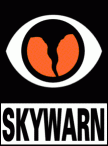
The effects of severe weather are felt every year by many Americans. In most years, thunderstorms, tornadoes and lightning caused hundreds of injuries and deaths and billions in property and crop damages. To obtain critical weather information, the National Weather Service (NWS) established SKYWARN® with partner organizations. SKYWARN® is a citizen volunteer program with between 350,000 and 400,000 trained severe weather spotters. SKYWARN® storm spotters are citizens who form the nation's first line of defense against severe weather. These volunteers help keep their local communities safe by providing timely and accurate reports of severe weather to the National Weather Service.
Although SKYWARN® spotters provide essential information for all types of weather hazards, the main responsibility of a SKYWARN® spotter is to identify and describe severe local storms. In an average year, the the United States experiences more than 10,000 severe thunderstorms, 5,000 floods and more than 1,000 tornadoes.
Since the program started in the 1970s, the information provided by SKYWARN® spotters, coupled with Doppler radar technology, improved satellite and other data, has enabled NWS to issue more timely and accurate warnings for tornadoes, severe thunderstorms and flash floods. Storm spotters play a critical role because they can see things that radar and other technological tools cannot, and this ground truth is critical in helping the NWS perform our primary mission, to save lives and property.
Across Northern Colorado, dedicated volunteers risk their personal safety to provide first-hand severe weather reports to their local officials, and the National Weather Service (NWS) in Boulder. Their reason, to help protect the lives and property of the citizens in Northern Colorado.
Being a storm spotter not only means dedication, but also training. Each spring the NWS in Denver/Boulder trains members of the public, police, fire department, emergency management, and amateur radio community, in the latest storm spotting techniques, basic weather concepts, and preparedness and planning. Typically the training is coordinated by a local group such as an emergency management agency or HAM radio operator. A NWS meteorologist serves as the guest instructor.
We ask participants to be at least 18 years of age or older but encourage younger people to help adults report severe weather in their area.
The goal of the training is to prepare the spotter to identify hazardous weather conditions, how to report that information to the local NWS, and personal safety.
There are also a number of in-person seminars scheduled. These seminars are free of charge and many are open to the public. Each seminar is approximately 1 1/2 to 2 hours in length and most often held in evening on a weekday. We ask that you pre-register for the classes in order to get a better head count on attendance. You are allowed to attend classes outside your county of residence.
 |
Instructions for printing your Skywarn™ certificate online |
| Your Name |
Code |
When to send a severe storm report?
When you can do safely, please send us a report when you observe one or more of the following:
Definitions:
Please include in your report, the location (town and county) and time/date that the severe weather occurred.
If you can supply a picture of the severe weather you are experiencing, please do.
When to send a winter storm report?
How to send us a storm report.
This course is NOT produced by your local NWS office in Boulder.
There are two courses, including: "Role of the Skywarn Spotter" and "Skywarn Spotter Convective Basics".
These courses cover the basics of being a Skywarn Spotter. They are free and accessible from the METED website. www.meted.ucar.edu
Local Resources
SKYWARN Amateur Radio Local Groups
Online SKYWARN Spotter and Severe Weather Training Resources
For more information contact:
Russell Danielson and Greg Heavener
E-mail: Email